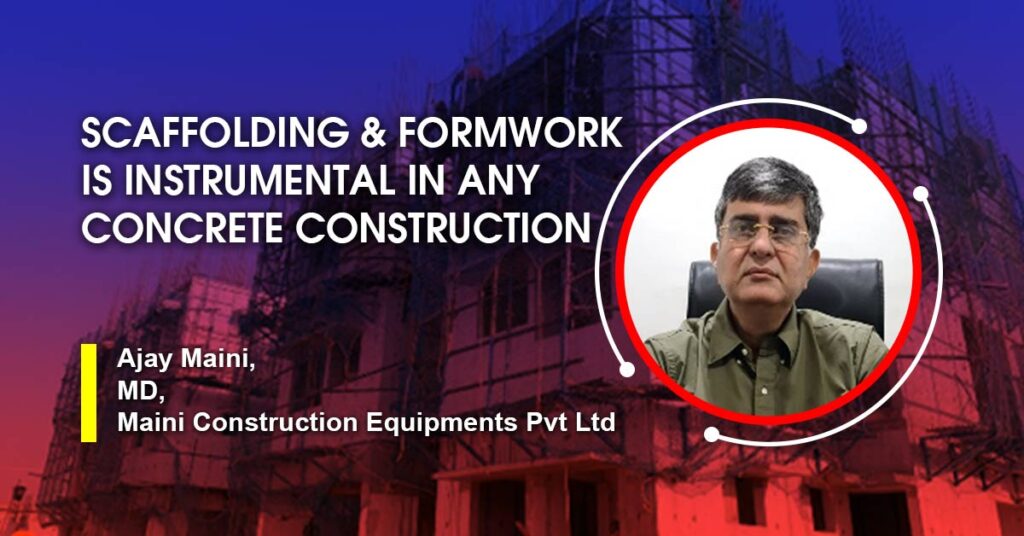The changing market trend in the realty segment in the early 2000s gave rise to developing new formwork for fast, safe and quality construction of high-rise buildings and mass housing projects in India, says Ajay Maini, MD, Maini Construction Equipments Pvt Ltd.
Could you shed some light on MAINI Aluminium Formwork System and its advantages?
MAINI Aluminium Formwork System is an outcome of the Group’s vision and a passion to provide innovative solutions in the formwork and scaffolding segment, which has been in the formwork and scaffolding manufacturing industry since 1986. The changing market trend in the realty segment in the early 2000s gave rise to developing new formwork for fast, safe and quality construction of high-rise buildings and mass housing projects in India.
With rising demands by customers for new technology in construction, the Group’s R&D team initiated intensive research. After two years of working and prototype models, a new aluminium formwork system was developed for the domestic customers. This is when the Group set up a new venture, Maini Scaffold System, the first company in India to manufacture aluminium formwork in 2007. The major advantages of aluminium formworks are as follows:
- The speed of construction, i.e. the slab cycle is brought down from 15 days to seven days.
- As our aluminium formwork is manufactured to precise tolerance using high-quality aluminium alloy, there is no skilled labour required like carpenters thus saving labour input costs and dependency as semi-skilled labour can also work on the system.
- The handling of aluminium formwork is easy as lightweight, hence no capital investment in tower crane at the site.
- As aluminium formwork gives super form finish to concrete, no plastering is required, hence huge savings.
- Around 65-75 per cent of the aluminium formwork can be reused for another project depending on the design of the building.
What kind of latest technological trends are we witnessing in the scaffolding & formwork industry?
Scaffolding & Formwork is instrumental in any concrete construction and has been in use for decades but as time changes so does the technology, and that goes with construction too. During early days of concrete construction, bamboos were being used as scaffolding and then came tubular steel in the form of ‘H’ frames. With the development of forged components in combination with tubular steel, Cuplock Scaffolding was introduced, which was faster to assemble and dismantle than the ‘H’ frame. Further development of Quick Stage scaffolding which was a combination of spring integrated quick lock system with tubular steel which eased the erection and dismantling further.
As for formwork, the same has transformed from timber during the early days of concrete construction to steel formwork which was very popular up to the early 2000s. Now, with new technology, plastic and aluminium modular formworks have become more popular replacing steel. But the aluminium formwork is more popular compared to plastic formwork as it gives more repetitions and can be modified to a certain extent and most importantly, it has a resale value.
What is your take on cost-efficiency and safety practices while using Scaffolding & Formwork at a construction project?
Considering the timber and ply or even steel centring being used in the construction earlier, the initial cost is more, however, considering the ratio of cost to the lifecycle, the aluminium formwork turns out more economical in the long run. The same goes for tubular mild steel scaffolding, the initial cost compared to bamboo scaffolding being used earlier is more, but in the long run, it is economical and safer considering the coupling/locking system incorporated in scaffolding.
Being a pioneer and industry leader in aluminium formwork and scaffolding, quality and safety is our prime focus. The primary safety in scaffolding is the raw material, i.e., the pipes. We use pipes having ISI mark for manufacturing Cuplock Scaffolding, Props and H-frames. For aluminium, we use high-grade Aluminium Alloy 6061 T6. Our system is provided with proper work platforms and safety hand-rails for edge protection in the lift shat and external side on the façade of the building for the safety of labourers and engineers during construction.
How are you managing your sales and after-sales services in the current market condition?
Last year was a lesson for all of us to find new ways to work. With the experience of working in a difficult situation during and after the lockdown in 2020, new ideas and skills have been developed and people have the experience working and coordinating in the lockdown. As far as sales and after-sales are concerned in the current lockdown, the team is well connected with the design, production and back-office team for support. For the safety of both our team as well as clients, before the lockdown was announced this year (2021), we had taken the precaution of attending only important meetings and site visits. We adopted the virtual meetings via online platforms. The world will come out of this situation soon but till then we all will have to take mandatory precautions to keep us and everyone safe.
Cookie Consent
We use cookies to personalize your experience. By continuing to visit this website you agree to our Terms & Conditions, Privacy Policy and Cookie Policy.

















